While most kitchen windows receive 4-6 hours of indirect sunlight daily, many homeowners overlook this prime growing space for indoor plants. You’ll find that this natural light exposure creates an ideal environment for both decorative and edible varieties, particularly when positioned 6-12 inches from the glass. By selecting the right combination of herbs, flowering plants, and trailing vines, you can transform your kitchen window into a practical growing station that enhances both your cooking and decor.
Contents
- 1 Fresh Herbs: The Kitchen Gardener’s Essential Companions
- 2 Resilient Succulents for Sunny Windowsills
- 3 Compact Spider Plants: Natural Air Purifiers
- 4 Cheerful Pothos: The Low-Maintenance Beauty
- 5 Microgreens: Your Window to Fresh Salad Ingredients
- 6 Compact Snake Plants for Vertical Appeal
- 7 Fragrant African Violets: Colorful Kitchen Charm
Fresh Herbs: The Kitchen Gardener’s Essential Companions
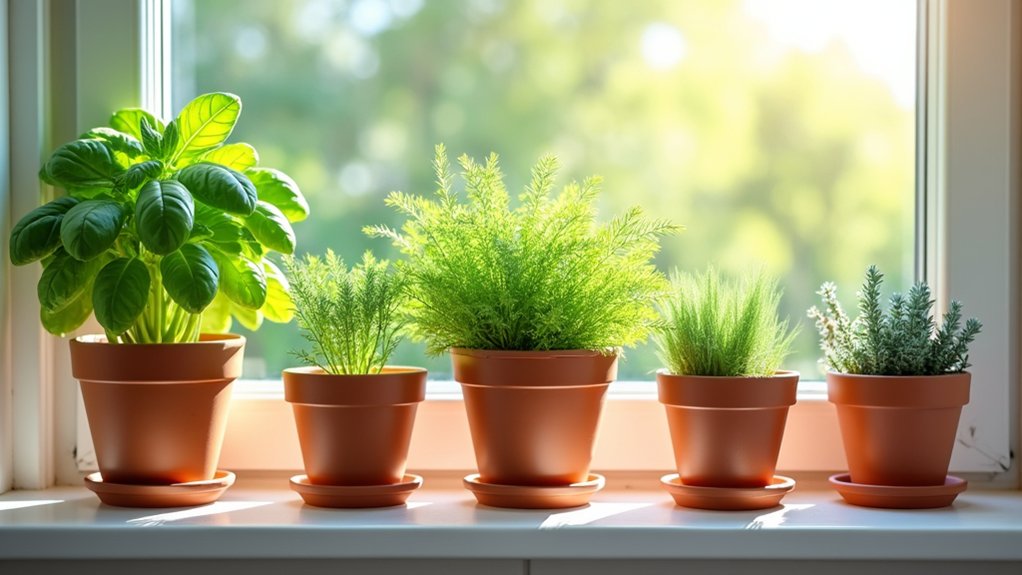
Fresh herbs are compact, aromatic plants that bring both culinary value and natural beauty to kitchen windowsills. These versatile plants range from bushy basil and feathery dill to creeping thyme and upright rosemary, offering various textures, heights, and shades of green.
Most kitchen herbs produce flavorful leaves throughout the growing season, making them practical additions to daily cooking while serving as living decorative elements.
- Light: 6-8 hours of direct sunlight daily, preferably south-facing windows
- Water: Moderate watering when top inch of soil feels dry; avoid waterlogged soil
- Soil: Well-draining potting mix enriched with organic matter
- Temperature: 65-70°F (18-21°C), with good air circulation
- Container: Pots with drainage holes, sized appropriately for each herb
- Humidity: Moderate humidity levels, avoiding dry heated air
- Spacing: 6-12 inches between plants, depending on variety
Regular harvesting actually promotes bushier growth and prevents herbs from becoming leggy. Remove flower buds as they appear to maintain leaf production and flavor intensity.
Rotate containers quarterly for even growth, and fertilize monthly during growing season with diluted organic fertilizer. Prune dead or yellowing leaves promptly to prevent disease spread, and avoid harvesting more than one-third of the plant at once to ensure continuous growth.
Resilient Succulents for Sunny Windowsills
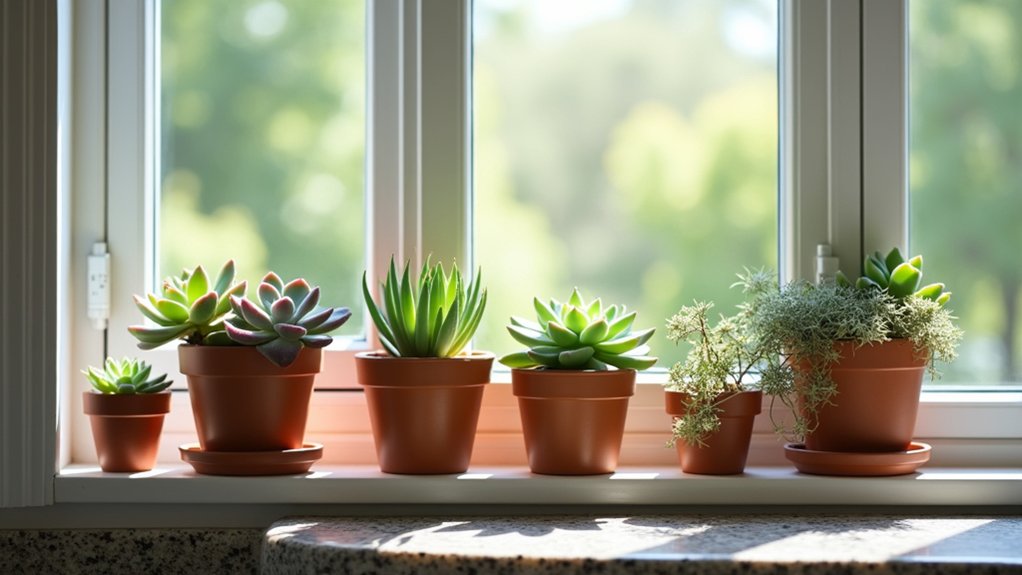
Succulents are compact, water-retaining plants with thick, fleshy leaves that make perfect additions to sunny kitchen windowsills. These architectural beauties come in a variety of shapes, sizes, and colors, from rosette-forming echeverias to trailing string-of-pearls and upright jade plants.
Their modern aesthetic and structural forms create eye-catching displays while requiring minimal space, making them ideal for window ledges and countertop gardens.
- Light: Bright, direct sunlight for 4-6 hours daily; south or west-facing windows are optimal
- Water: Allow soil to dry completely between waterings; reduce watering in winter
- Soil: Well-draining cactus or succulent mix; add perlite or coarse sand for better drainage
- Temperature: 60-80°F (15-27°C); can tolerate occasional temperature fluctuations
- Humidity: Low to moderate; tolerates typical indoor humidity levels
- Container: Pots with drainage holes; terracotta or unglazed ceramic preferred
Regular maintenance for windowsill succulents focuses on preventing common issues rather than frequent care.
Remove any dead or yellowing leaves promptly to prevent rot, rotate containers quarterly for even growth, and dust leaves gently with a soft brush to maintain their ability to photosynthesize effectively.
During active growing seasons (spring and summer), apply a diluted cactus fertilizer every 6-8 weeks, and inspect occasionally for mealybugs or scale insects, which can be removed with rubbing alcohol on a cotton swab.
Compact Spider Plants: Natural Air Purifiers
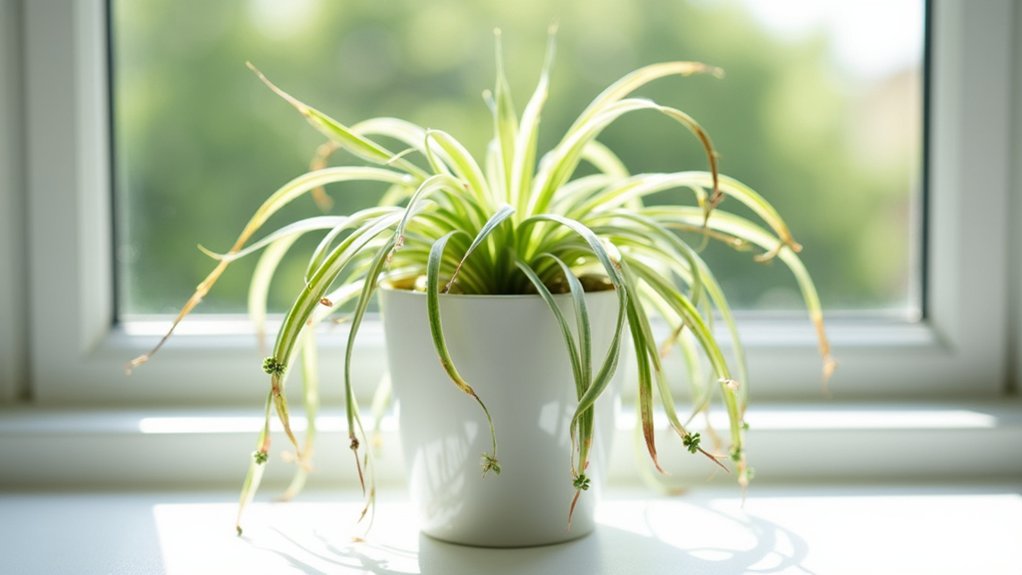
Compact Spider Plants (Chlorophytum comosum) are efficient natural air purifiers that make excellent additions to kitchen windows. These graceful plants feature arching leaves in solid green or variegated patterns, growing in dense rosettes that produce long stems with baby plantlets, creating a cascading effect. Their smaller size compared to standard spider plants makes them particularly suitable for window spaces, while still maintaining their ability to remove indoor air pollutants like formaldehyde and carbon monoxide.
- Light: Bright, indirect sunlight; can tolerate moderate light but avoid direct sun
- Water: Keep soil consistently moist but not waterlogged; water when top inch of soil feels dry
- Soil: Well-draining potting mix with good aeration
- Temperature: 60-75°F (15-24°C)
- Humidity: Moderate to high; tolerates average household humidity
- Container: Pot with drainage holes; choose compact containers to control size
Regular grooming keeps compact spider plants looking their best and promotes healthy growth. Remove any yellowed or damaged leaves at the base, and trim off brown leaf tips, which can occur from tap water minerals.
When plantlets appear, either remove them to prevent energy drain or pot them up to create new plants. Feed with a balanced liquid fertilizer once monthly during the growing season, and reduce fertilization in winter.
Rotating the pot quarterly ensures even growth, as these plants will naturally grow toward light sources.
Cheerful Pothos: The Low-Maintenance Beauty
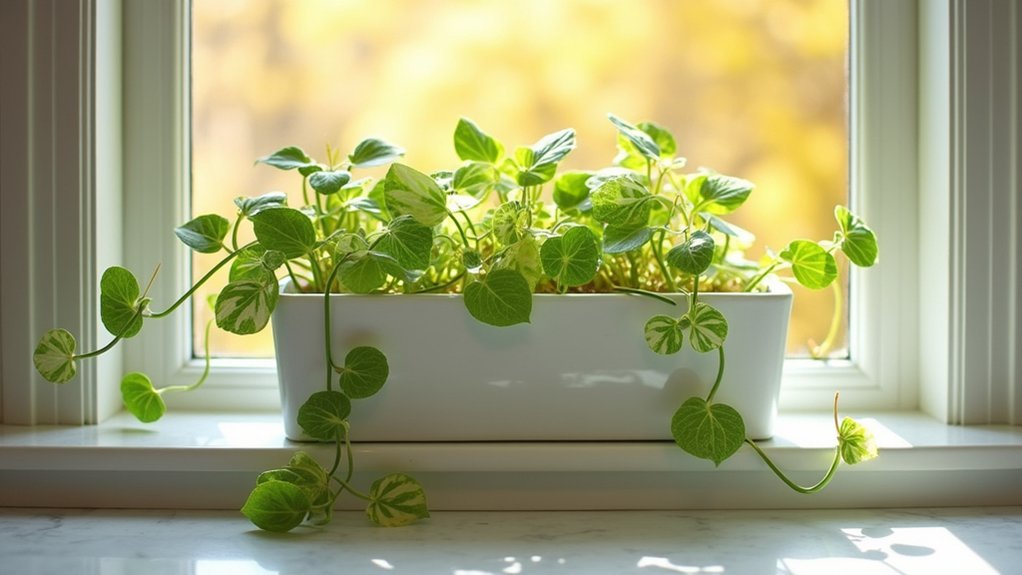
Pothos (Epipremnum aureum) is a versatile and resilient vine with heart-shaped leaves that come in various patterns of green, yellow, and white variegation. Its trailing stems can grow several feet long, creating cascading foliage that brightens any kitchen window.
The plant’s natural ability to purify air and its forgiving nature make it an excellent choice for both novice and experienced plant parents.
- Light: Thrives in bright, indirect light but tolerates low light conditions
- Water: Allow top 1-2 inches of soil to dry between waterings
- Soil: Well-draining potting mix
- Temperature: Comfortable in normal room temperatures (60-80°F)
- Humidity: Adapts to average indoor humidity levels
- Container: Any pot with drainage holes
Regular pruning helps maintain the pothos’s desired shape and promotes fuller growth.
Remove yellowing or damaged leaves promptly, and wipe the leaves occasionally with a damp cloth to remove dust and maintain their glossy appearance.
While the plant can survive with minimal care, monthly feeding with a balanced houseplant fertilizer during the growing season will encourage optimal growth and maintain vibrant variegation.
Microgreens: Your Window to Fresh Salad Ingredients
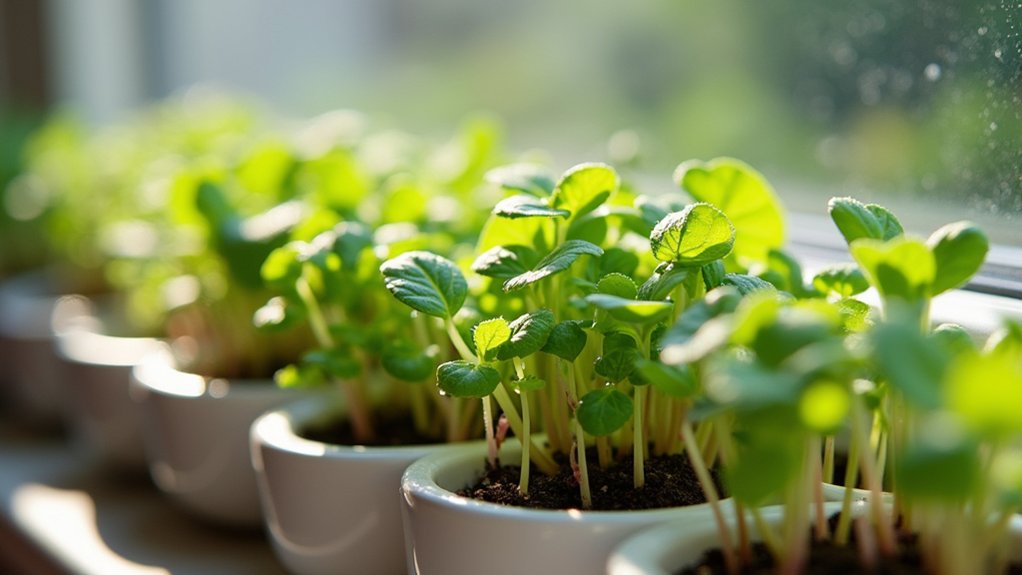
Microgreens are miniature edible plants harvested when they’re just 1-3 inches tall, typically showing their first set of true leaves. These tiny powerhouses pack intense flavors and concentrated nutrients, often containing up to 40 times more nutrients than their mature counterparts.
Popular varieties include radish, basil, cilantro, and sunflower microgreens, which add vibrant colors, textures, and gourmet appeal to salads, sandwiches, and garnishes.
- Light requirements: 4-6 hours of direct sunlight daily or 12-16 hours under grow lights
- Soil: Light, sterile seed-starting mix with good drainage
- Water: Keep soil consistently moist but not waterlogged
- Temperature: 65-75°F (18-24°C)
- Container depth: 1.5-2 inches deep with drainage holes
- Spacing: Seeds can be planted densely, about 1/4 inch apart
- Growing time: 7-21 days from seeding to harvest
Maintaining healthy microgreens requires attention to air circulation and disease prevention. Use a small fan to reduce humidity and prevent mold growth, and water from the bottom to avoid displacing tiny seedlings.
Harvest entire trays at once using clean scissors when the first true leaves are fully developed, as microgreens don’t regrow after cutting. Start new trays every week or two for continuous harvests, and thoroughly clean containers between crops to prevent disease transmission.
Compact Snake Plants for Vertical Appeal
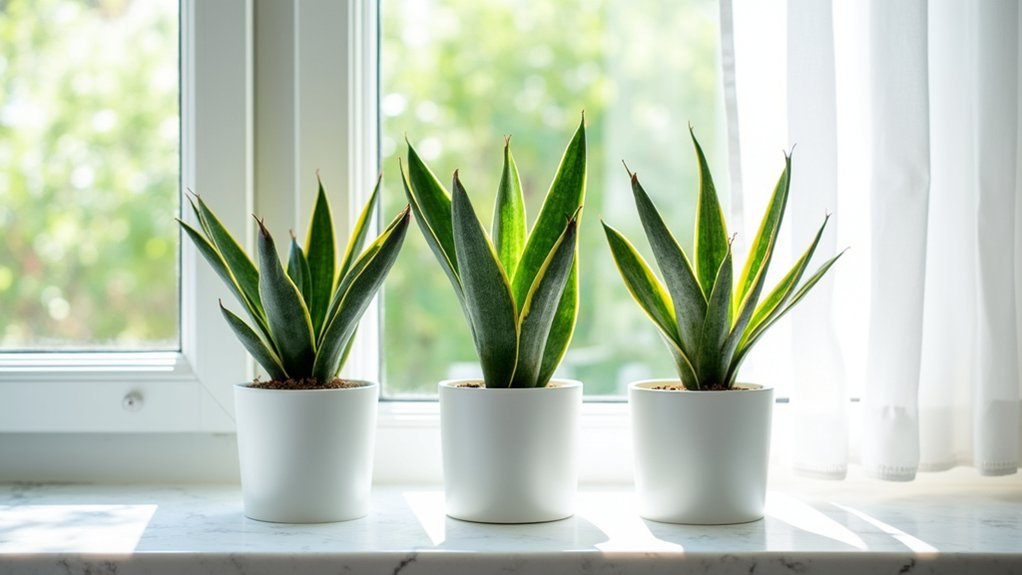
Compact snake plants (Sansevieria trifasciata) are ideal vertical-growing houseplants for kitchen windows, featuring stiff, upright leaves that can reach 6-12 inches in height.
These architectural plants display striking patterns of green and yellow variegation on their sword-shaped foliage, growing in tight clusters that maintain a slim footprint. Their compact nature makes them perfect for narrow windowsills while still providing visual impact through their strong vertical lines.
- Light: Tolerates low light but thrives in bright, indirect sunlight
- Water: Allow soil to dry between waterings; water less in winter
- Soil: Well-draining potting mix with added perlite or sand
- Temperature: 65-85°F (18-29°C)
- Humidity: Adaptable to any humidity level
- Container: Small pot with drainage holes; slightly root-bound is acceptable
Regular maintenance for compact snake plants is minimal but important.
Remove any yellowed or damaged leaves at the base, and dust the leaves monthly with a damp cloth to maintain their ability to photosynthesize efficiently.
Rotate the pot quarterly to ensure even growth, and check for signs of root rot, which can develop if the plant is overwatered.
These plants rarely need repotting, typically only every 2-3 years when they become extremely root-bound.
Fragrant African Violets: Colorful Kitchen Charm
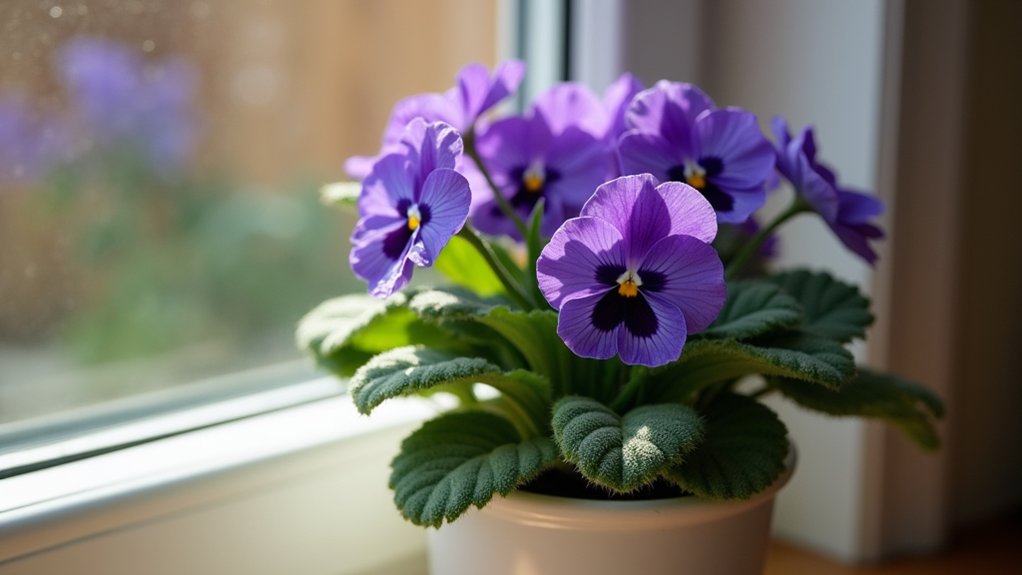
African Violets bring delightful bursts of color and a subtle, sweet fragrance to kitchen windowsills with their clusters of velvet-textured blooms in shades of purple, pink, white, or blue.
These compact plants feature rounded, fuzzy leaves that form a symmetrical rosette pattern, making them perfect for small spaces while providing year-round flowering potential when properly maintained.
- Light: Bright, indirect sunlight; avoid direct afternoon sun
- Water: Keep soil consistently moist but not waterlogged; water from bottom
- Temperature: 65-75°F (18-24°C)
- Humidity: 50-60%
- Soil: Light, well-draining African Violet potting mix
- Container: Small pot with drainage holes
- Fertilizer: Balanced, water-soluble fertilizer designed for African Violets
Regular grooming is essential for keeping African Violets healthy and promoting continuous blooming.
Remove spent flowers and damaged leaves promptly, rotate the pot quarterly for even growth, and avoid getting water on the leaves to prevent spotting and crown rot.
Repot annually in fresh soil, choosing a container just slightly larger than the root ball, and maintain good air circulation around the plant while keeping it away from cold drafts or heating vents.
